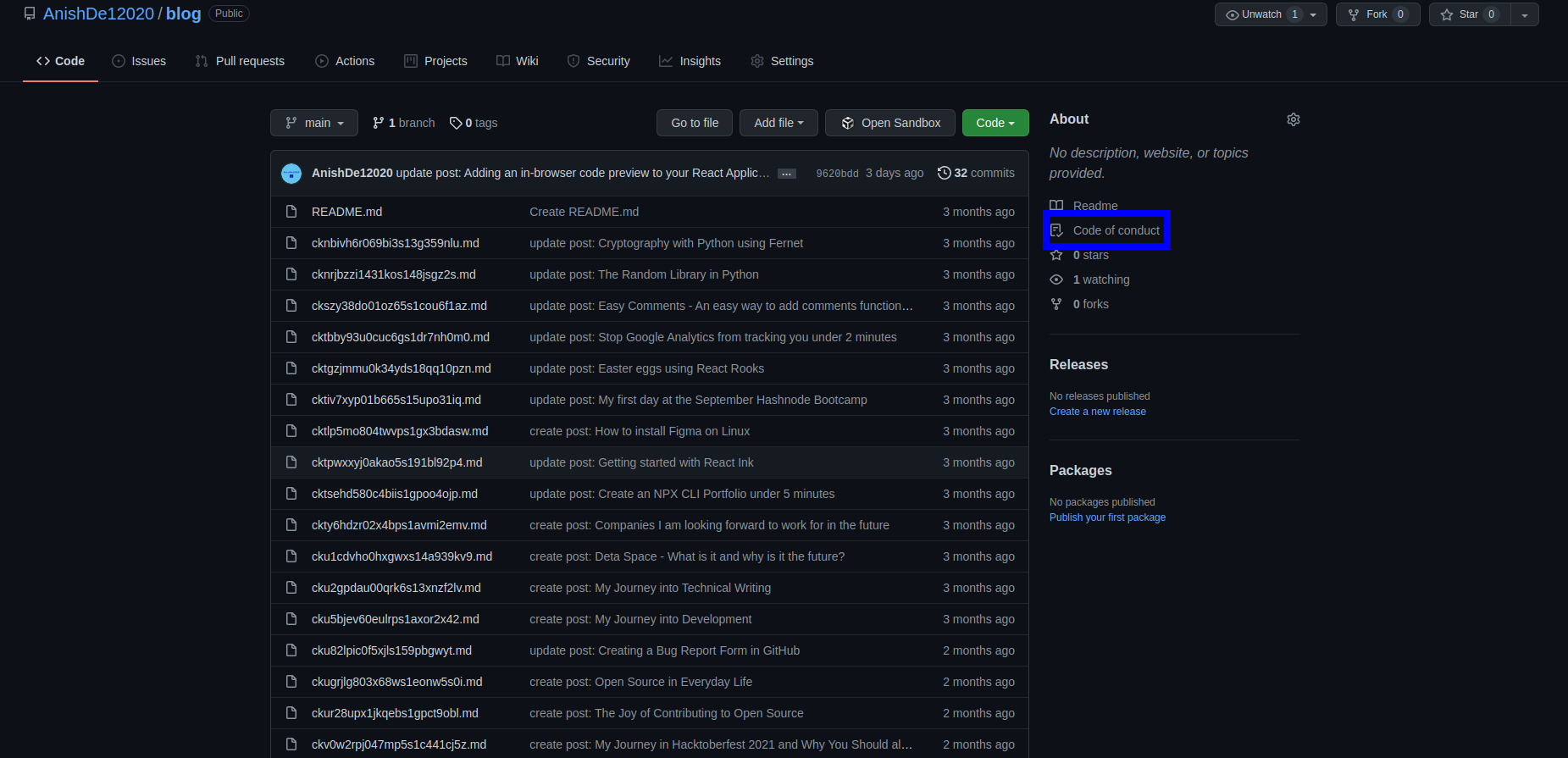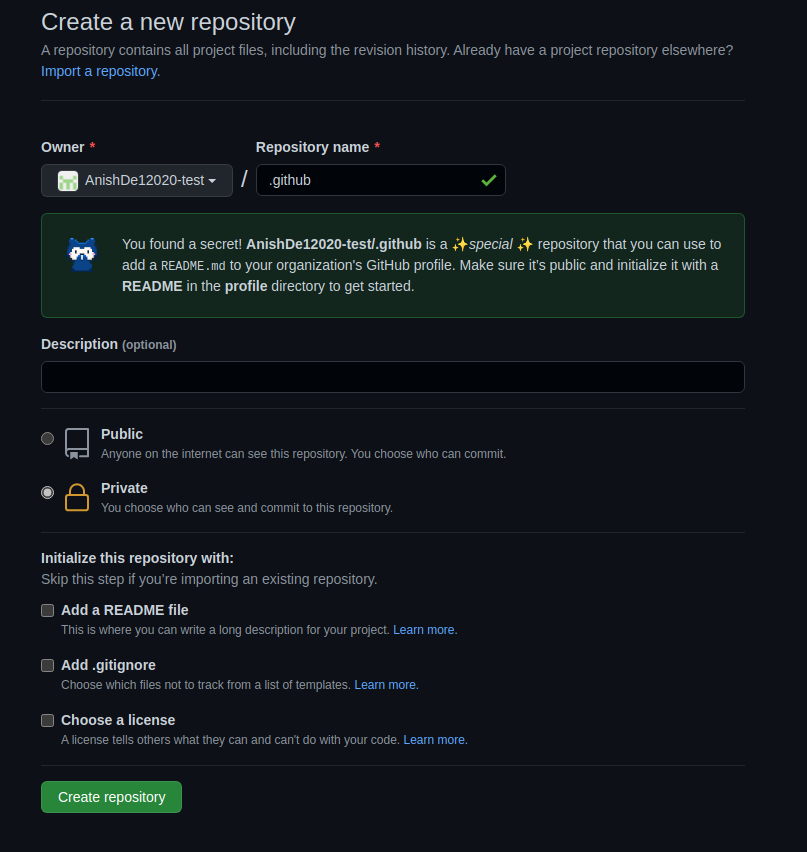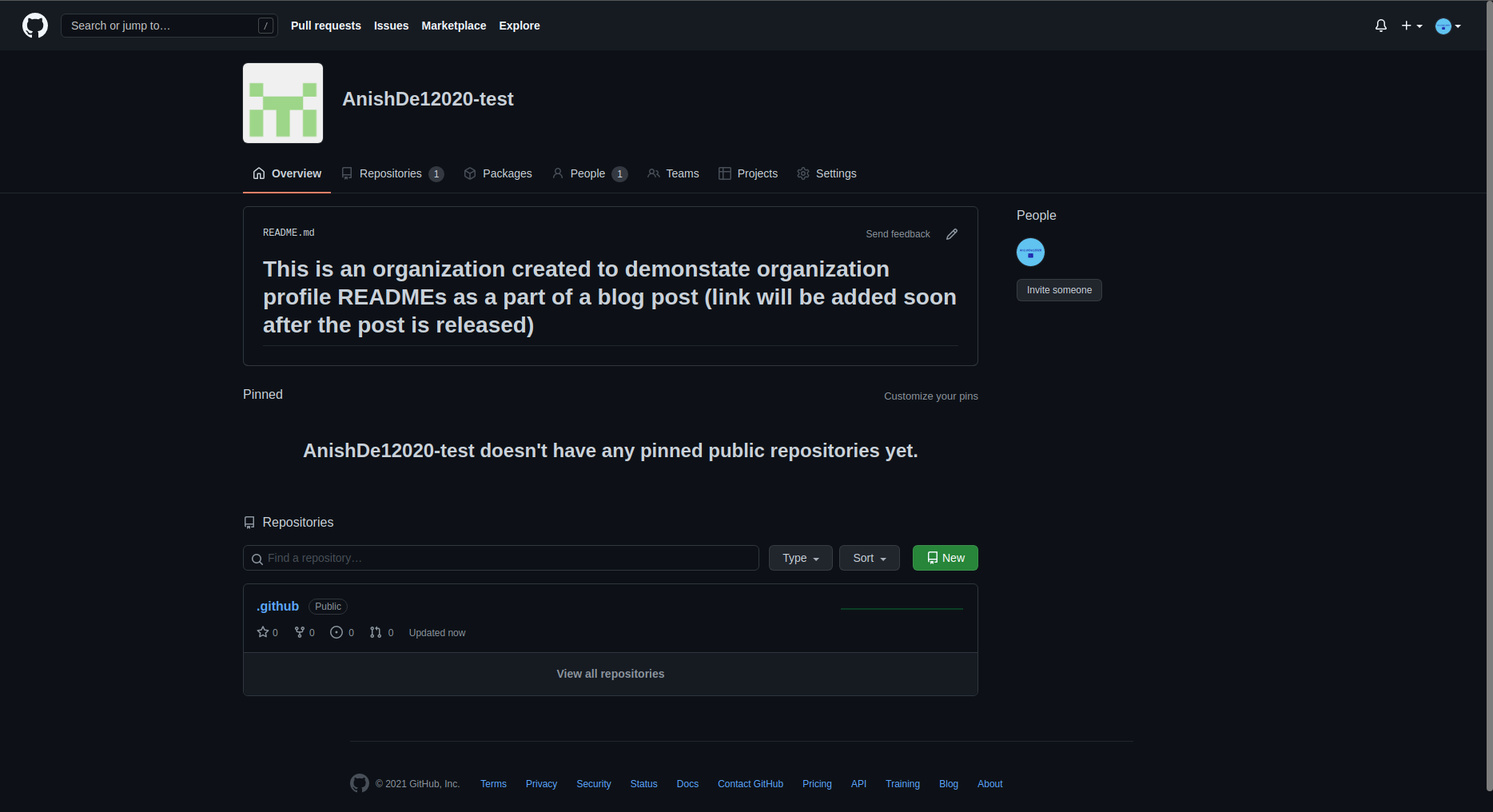By Anish De
GitHub has many special repositories. For instance, you can create a repository that matches your username, add a README file to it, and all the information in that file will be visible on your GitHub profile.
You might already be familiar with the .github directory you'll find in many repositories. The .github directory houses workflows, issue templates, pull request templates, funding information, and some other files specific to that project.
But another special repository you can create is the .github repository. It acts as a fallback for all of your repositories that don't have an actual .github directory with issue templates and other community health files.
For example, say I have a repository named .github with generic bug report and feature request issue templates. And say I create another repository called new-project, but I don't add a .github directory with issue templates to it.
Then if someone goes to the new-project repo and opens an issue, they'll be presented with an option to choose from the generic templates already in the .github directory.
Similarly, if I add a code of conduct to my .github repository, it will be shown across all my repositories that don't explicitly have one.
Just note that the files inside a repository's .github directory will be chosen over the ones in the .github directory. For example, if my new-project repo has a .github directory with a feature request issue template inside, that will be used instead of the generic feature request template from the .github repo.
Let's see how this special repository works in action.
How to Use .github on Personal GitHub Accounts
Creating this special repository is as easy as creating any other repository on GitHub. So go ahead and open GitHub on your web browser and create the repository like this:
 Creating a .github repository on my personal GitHub account
Creating a .github repository on my personal GitHub account
After you're done creating the repository, you can start adding files to it. The first file I will add is a bug report issue form. I am not going to go over the details of creating an issue form in this article, but you can have a look at a previous article I wrote about GitHub Issue forms.
.github/ISSUE_TEMPLATE/bug_report.yml
name: 🐛Bug Report
description: File a bug report here
title: "[BUG]: "
labels: ["bug"]
assignees: ["AnishDe12020"]
body:
- type: markdown
attributes:
value: |
Thanks for taking the time to fill out this bug report 🤗
Make sure there aren't any open/closed issues for this topic 😃
- type: textarea
id: bug-description
attributes:
label: Description of the bug
description: Give us a brief description of what happened and what should have happened
validations:
required: true
- type: textarea
id: steps-to-reproduce
attributes:
label: Steps To Reproduce
description: Steps to reproduce the behavior.
placeholder: |
1. Go to '...'
2. Click on '...'
3. Scroll down to '...'
4. See error
validations:
required: true
- type: textarea
id: additional-information
attributes:
label: Additional Information
description: |
Provide any additional information such as logs, screenshots, likes, scenarios in which the bug occurs so that it facilitates resolving the issue.
I am also going to create a feature request form.
.github/ISSUE_TEMPLATE/feature_request.yml
name: ✨Feature Request
description: Request a new feature or enhancement
labels: ["enhancement"]
title: "[FEAT]: "
body:
- type: markdown
attributes:
value: |
Please make sure this feature request hasn't been already submitted by someone by looking through other open/closed issues
- type: textarea
id: description
attributes:
label: Description
description: Give us a brief description of the feature or enhancement you would like
validations:
required: true
- type: textarea
id: additional-information
attributes:
label: Additional Information
description: Give us some additional information on the feature request like proposed solutions, links, screenshots, etc.
I am also going to be adding a pull request template.
.github/pull_request_template.md
<!--
Thanks for creating this pull request 🤗
Please make sure that the pull request is limited to one type (docs, feature, etc.) and keep it as small as possible. You can open multiple prs instead of opening a huge one.
-->
<!-- If this pull request closes an issue, please mention the issue number below -->
Closes # <!-- Issue # here -->
## 📑 Description
<!-- Add a brief description of the pr -->
<!-- You can also choose to add a list of changes and if they have been completed or not by using the markdown to-do list syntax
- [ ] Not Completed
- [x] Completed
-->
## ✅ Checks
<!-- Make sure your pr passes the CI checks and do check the following fields as needed - -->
- [ ] My pull request adheres to the code style of this project
- [ ] My code requires changes to the documentation
- [ ] I have updated the documentation as required
- [ ] All the tests have passed
## ℹ Additional Information
<!-- Any additional information like breaking changes, dependencies added, screenshots, comparisons between new and old behavior, etc. -->
The last file I am going to be adding is a code of conduct – but this is going to be on the root of the repository. Despite that, this will work as intended (code of conduct files are usually kept on the root of the repository). Note that I am using the Contributor Convent convention.
CODE_OF_CONDUCT.md
# Contributor Covenant Code of Conduct
## Our Pledge
We as members, contributors, and leaders pledge to make participation in our
community a harassment-free experience for everyone, regardless of age, body
size, visible or invisible disability, ethnicity, sex characteristics, gender
identity and expression, level of experience, education, socio-economic status,
nationality, personal appearance, race, caste, color, religion, or sexual
identity and orientation.
We pledge to act and interact in ways that contribute to an open, welcoming,
diverse, inclusive, and healthy community.
## Our Standards
Examples of behavior that contributes to a positive environment for our
community include:
* Demonstrating empathy and kindness toward other people
* Being respectful of differing opinions, viewpoints, and experiences
* Giving and gracefully accepting constructive feedback
* Accepting responsibility and apologizing to those affected by our mistakes,
and learning from the experience
* Focusing on what is best not just for us as individuals, but for the overall
community
Examples of unacceptable behavior include:
* The use of sexualized language or imagery, and sexual attention or advances of
any kind
* Trolling, insulting or derogatory comments, and personal or political attacks
* Public or private harassment
* Publishing others' private information, such as a physical or email address,
without their explicit permission
* Other conduct which could reasonably be considered inappropriate in a
professional setting
## Enforcement Responsibilities
Community leaders are responsible for clarifying and enforcing our standards of
acceptable behavior and will take appropriate and fair corrective action in
response to any behavior that they deem inappropriate, threatening, offensive,
or harmful.
Community leaders have the right and responsibility to remove, edit, or reject
comments, commits, code, wiki edits, issues, and other contributions that are
not aligned to this Code of Conduct, and will communicate reasons for moderation
decisions when appropriate.
## Scope
This Code of Conduct applies within all community spaces, and also applies when
an individual is officially representing the community in public spaces.
Examples of representing our community include using an official e-mail address,
posting via an official social media account, or acting as an appointed
representative at an online or offline event.
## Enforcement
Instances of abusive, harassing, or otherwise unacceptable behavior may be
reported to the community leaders responsible for enforcement at
[INSERT CONTACT METHOD].
All complaints will be reviewed and investigated promptly and fairly.
All community leaders are obligated to respect the privacy and security of the
reporter of any incident.
## Enforcement Guidelines
Community leaders will follow these Community Impact Guidelines in determining
the consequences for any action they deem in violation of this Code of Conduct:
### 1. Correction
**Community Impact**: Use of inappropriate language or other behavior deemed
unprofessional or unwelcome in the community.
**Consequence**: A private, written warning from community leaders, providing
clarity around the nature of the violation and an explanation of why the
behavior was inappropriate. A public apology may be requested.
### 2. Warning
**Community Impact**: A violation through a single incident or series of
actions.
**Consequence**: A warning with consequences for continued behavior. No
interaction with the people involved, including unsolicited interaction with
those enforcing the Code of Conduct, for a specified period of time. This
includes avoiding interactions in community spaces as well as external channels
like social media. Violating these terms may lead to a temporary or permanent
ban.
### 3. Temporary Ban
**Community Impact**: A serious violation of community standards, including
sustained inappropriate behavior.
**Consequence**: A temporary ban from any sort of interaction or public
communication with the community for a specified period of time. No public or
private interaction with the people involved, including unsolicited interaction
with those enforcing the Code of Conduct, is allowed during this period.
Violating these terms may lead to a permanent ban.
### 4. Permanent Ban
**Community Impact**: Demonstrating a pattern of violation of community
standards, including sustained inappropriate behavior, harassment of an
individual, or aggression toward or disparagement of classes of individuals.
**Consequence**: A permanent ban from any sort of public interaction within the
community.
## Attribution
This Code of Conduct is adapted from the [Contributor Covenant][homepage],
version 2.1, available at
[https://www.contributor-covenant.org/version/2/1/code_of_conduct.html][v2.1].
Community Impact Guidelines were inspired by
[Mozilla's code of conduct enforcement ladder][Mozilla CoC].
For answers to common questions about this code of conduct, see the FAQ at
[https://www.contributor-covenant.org/faq][FAQ]. Translations are available at
[https://www.contributor-covenant.org/translations][translations].
[homepage]: https://www.contributor-covenant.org
[v2.1]: https://www.contributor-covenant.org/version/2/1/code_of_conduct.html
[Mozilla CoC]: https://github.com/mozilla/diversity
[FAQ]: https://www.contributor-covenant.org/faq
[translations]: https://www.contributor-covenant.org/translations
We can add more files like funding information, contributing guides, and much more. For more information, you can look at the GitHub docs regarding community health files
The .github repository in action
My blogs repository doesn't have any issue templates, code of conduct, or any other file except for the markdown files of my blogs and a README. So it's the best repository to test upon if this feature is working or not.
I can already see the code of conduct appearing here:

If I try to create an issue, I am presented with the templates as well:

This will also work when creating a pull request.
How to Use the .github Repository for an Organization/Public Account
The .github repository on an organization account works just like the .github repository on a personal GitHub account – except there is one difference.
Organizations can also have profile READMEs that show up on the organization page on GitHub. This README resides on the profile directory of the organization's .github repository. To demonstrate this, I will quickly create a demo organization.
When creating the .github repository for an organization, you should get this message:

Also when adding the profile README to profile/README.md, you should be getting this message:
 Creating a GitHub organization README
Creating a GitHub organization README
Now, I am going to add some content to that README file and commit it. When I visit the organization's home page this is what we should see:
 Seeing GitHub organization profile README contents on the organization page
Seeing GitHub organization profile README contents on the organization page
Conclusion
I hope you now know what the .github repository does. You should also know how to set up default community health files for your repositories and a profile README for your organization.
Feel free to reach out to me on Twitter and have a nice day 😃
Resources
- GitHub Documentation on Community Health Files
- My
.githubrepository - My test organization's
.githubrepository - Contributor Convent
- Article on getting started with GitHub issue forms
I am currently working on a project called DevKit which is a PWA that will house developer tools in one single application and provide ways to get your work done quickly. Do check it out at https://www.devkit.one/.
